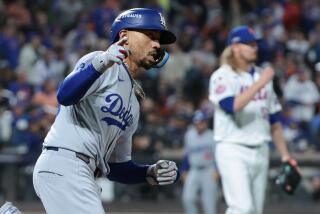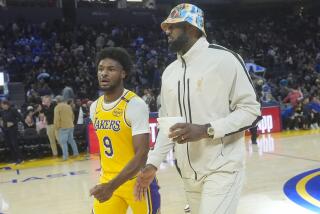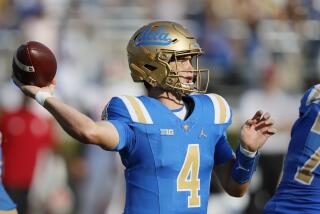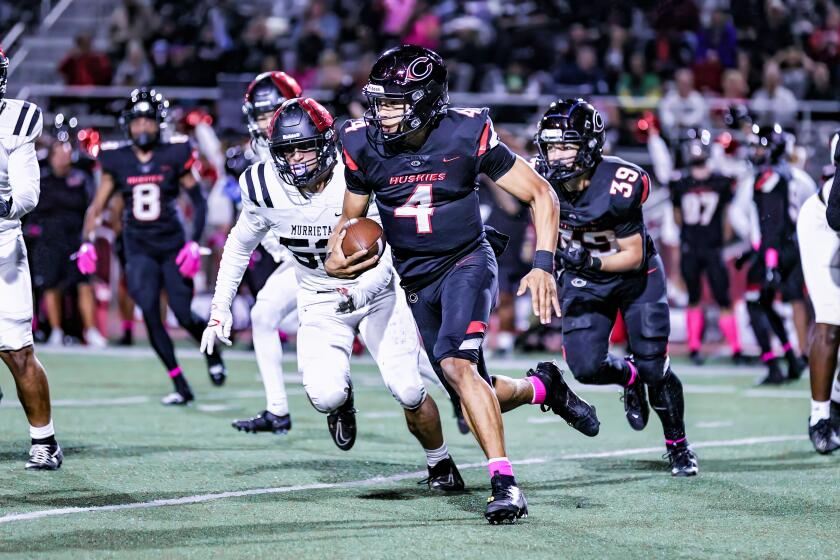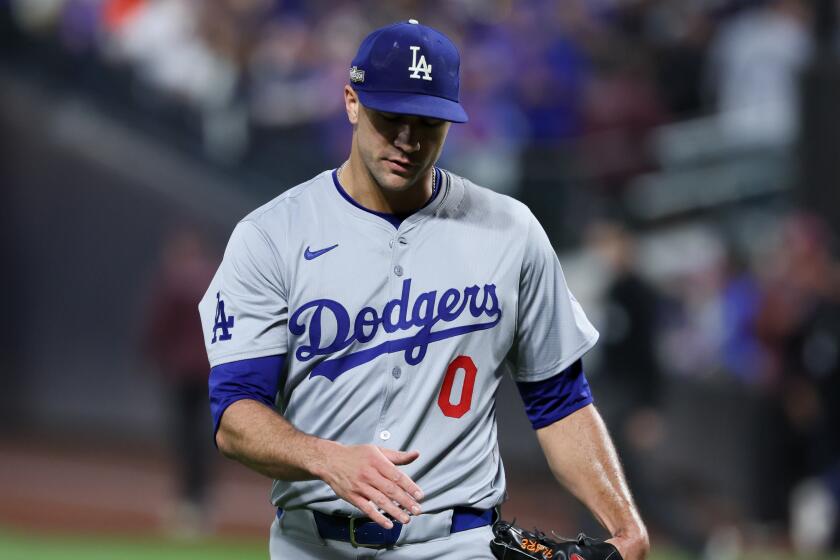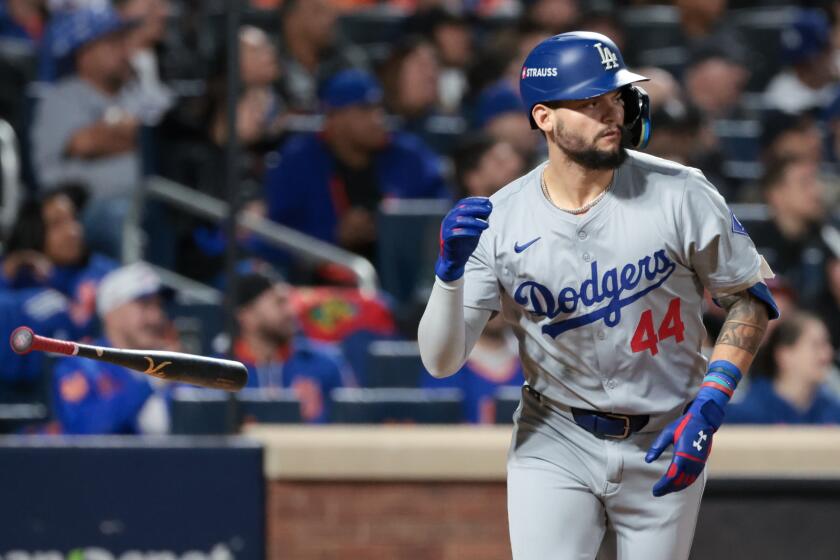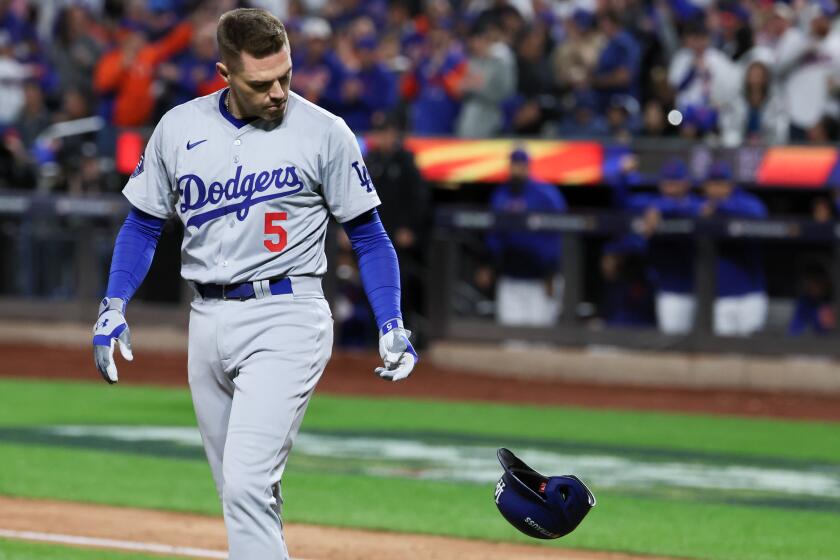SPORTS WEEKEND : Turf Wars : The Debate on Merits of Artificial and Natural Grass Resumes as More and More NFL Stars Go Down With Injuries
A sudden movement--a single step toward the ball--was all it took to rupture a tendon in Vinny Testaverde’s ankle.
A quick cut--a change of direction from right to left--was all it took to tear a ligament in Jamal Anderson’s knee.
And those two season-ending injuries--to premier players who weren’t so much as touched by defenders--were all it took to rekindle the annual debate over artificial turf.
This year’s version of the grass-versus-fake turf controversy involves the standard haggling between the NFL and its players, the usual contradictory research, some of which says artificial turf is more likely to cause injuries, some of which says it isn’t. But, this year, there are added twists.
Such as Coach Mike Ditka leading his Saints through passing drills on a patch of sod plopped down on a parking lot. And Jet Coach Bill Parcells wavering in his stubborn support of the fake stuff.
It’s enough to make Buccaneer defensive lineman Warren Sapp get downright philosophical.
“Are we willing, as a league and a society, to make that commitment to go out and protect our players?” Sapp asked. “Put the grass down and allow us to play the game.”
Artificial turf has been a point of contention for as long as people have been weaving synthetic yarns, laying them over rubber and asphalt and calling it a football field. As one NFL executive said: “This comes up every season.”
The seriousness of the issue was evident when Anderson spoke of getting hurt in Monday night’s game at Dallas. Stopping short of blaming the Texas Stadium carpet for his injury, the Falcon running back--who plays his home games on phony turf at the Georgia Dome--claimed to be a “purist” who believes “football should be played on grass.”
The NFL players’ association had harsher words.
“I’ve made the cut Jamal made a thousand times on grass and never hurt my knee,” said Clark Gaines, a former Jet running back who serves as the association’s regional director.
For the last five years, Gaines has surveyed players, lobbied owners and harangued the league in a crusade to get synthetic fields converted to grass. He has heard all the terms players use to describe the risks of playing on turf.
Terms such as “foot lock” and “turf toe.”
“It feels like you’ve been running on bricks for two miles,” Sapp said. “Your knees are real sore and usually you come out with nine or 10 scrapes and you don’t even know it until you get into the shower and it’s burning like hell.”
Players have complained loud enough that, in 1994, Gaines began conducting locker-room surveys. Last season, 96% of more than 900 players said artificial turf leaves them feeling sorer than grass. Ninety-four percent believe turf is more likely to contribute to an injury. Fifty percent identified a previous injury they believed to be caused by artificial turf.
In ranking the league’s stadiums, the players put Philadelphia, Cincinnati, Pittsburgh and New York--all artificial turf fields--at the bottom of the list.
“I think everyone in the league would love to see beautiful grass fields and sunny 72-degree weather for every game,” NFL spokesman Greg Aiello said. “But that’s not always possible.”
Harsh weather is only one reason 14 of the league’s 31 teams play on artificial turf. Cost is another factor, for the teams and the municipalities that control some stadiums. Grass needs constant upkeep, hundreds of thousands of dollars in manpower and mowers, water and fertilizer each year. Plastic turf requires little more than sweeping and occasional repainting.
Equally important, some stadium administrators consider grass too fragile to withstand a football season that may include other events ranging from baseball games to concerts to tractor pulls.
“Let me tell you, a regular grass field getting that kind of play is going to become very uninviting,” said John Samerjan, spokesman for the New Jersey Sports and Exposition Authority, which operates Giants Stadium. “That has been the main issue. . . . Can you come up with a grass field that could take the number of football games and all the other events?”
While stadiums grapple with this question, the NFL takes pains to distinguish between preference and risk. Aiello said, “If you don’t like artificial turf, when you see an injury you’ll blame the turf. But the doctors we deal with say that is a simplistic answer.”
The league commissioned John Powell, an Iowa sports-injury consultant, to conduct several studies during the 1980s. NFL executives are quick to point out that Powell, after collecting injury reports from team trainers, found no significant difference between the number of serious injuries on artificial turf and grass.
“There are noncontact injuries that occur on grass too,” Aiello said. “This past Sunday in Kansas City, the Chiefs had a running back, Kimble Anders, who is out for the year. Same injury as Testaverde but on grass.
“And in the same game, the Broncos lost John Mobley for the year to a knee injury. Unfortunately, injuries are part of the game.”
More recent studies paint a different picture. In 1997, Dr. Willibald Nagler of Cornell University collected reports from 25 medical journals and concluded that foot and knee injuries occur 50% more often on artificial turf. Among the main culprits is what players call “foot lock” or, as Nagler wrote, “increased friction between the football shoe and the turf” that causes a runner’s foot to catch on the carpet.
Available studies, however, are too scattershot to produce a definitive answer, another researcher said.
Eric Zemper began collecting reports on football injuries in the mid-1980s when he was the NCAA’s research coordinator. Now, as a nonprofit consultant in Eugene, Ore., he has begun to analyze 15 years’ worth of data, hoping for clarity amid the bluster.
“There are a lot of vested interests in this thing,” Zemper said. “The players are looking at things that fit their needs and the league is looking at things that fit its needs.”
The issue could eventually become moot. The NFL’s newest fields in Cleveland, Baltimore, Carolina and Jacksonville have grass. Seattle and Cincinnati will switch when their new stadiums open.
And technology is making it possible to convert existing fields, even in domed stadiums.
The Saints played an exhibition game against the Packers with removable grass laid on the Superdome floor. This was after an earlier experiment in which the sod grower rolled 35 yards of the stuff across a parking lot outside. Ditka brought the scout team to run drills.
“It was very successful,” said Greg Suit, a team executive. “We all know the buzz, and the buzz is, ‘Let’s play on grass.’ So that’s our long-term goal.”
The field could be used on Sundays, then whisked away to a nearby, outdoor location for the rest of the week. The team is hoping the cost--about $3 million a season--will come down.
Giants Stadium has also experimented the last two summers with interlocking trays of grass that can be replaced when the field becomes worn in spots. The system costs $1 million per team to install and $400,000 a year to maintain, but two of the stadium’s tenants--the Giants and the MetroStars of Major League Soccer--are reportedly leaning toward using it full time.
The Jets have been a sticking point, with Parcells saying last December he is “generally for grass” but unconvinced it would survive under the cleats of three professional teams. Injuries to Testaverde, receiver Wayne Chrebet and running back Leon Johnson could be swaying him.
“It was a little worn in the middle but that’s the great thing about it,” he told the Associated Press after an exhibition game on the “tray” field last month. “They can put grass in whenever they want.”
Team and stadium executives will meet again soon to discuss a switch. It cannot happen soon enough for Gaines, who doesn’t need research to confirm his beliefs.
“Isn’t that worth saving Vinny Testaverde?” he asked of using grass. “It seems that if you pay $3 million to a player and put him on a surface you’re not sure is safe . . . that’s just a poor business decision.”
More to Read
Go beyond the scoreboard
Get the latest on L.A.'s teams in the daily Sports Report newsletter.
You may occasionally receive promotional content from the Los Angeles Times.
